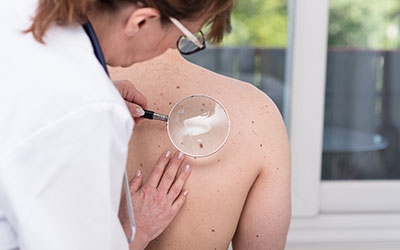Annual Skin Exams Save Lives
 Ever question why you need a skin exam every year? Consider it the best type of medicine — prevention. Consistently having a dermatology provider assess your skin is instrumental in detecting skin cancer early, when it’s most treatable. The regularity of an annual exam means your provider has an opportunity to notice small changes in your skin that may become problematic in the future. “Yearly skin exams are easy, accessible ways to ensure any concerning spots are checked and removed if needed,” says Dr. Jason Miller, a board-certified dermatologist at Schweiger Dermatology & Allergy in Freehold, NJ.
Ever question why you need a skin exam every year? Consider it the best type of medicine — prevention. Consistently having a dermatology provider assess your skin is instrumental in detecting skin cancer early, when it’s most treatable. The regularity of an annual exam means your provider has an opportunity to notice small changes in your skin that may become problematic in the future. “Yearly skin exams are easy, accessible ways to ensure any concerning spots are checked and removed if needed,” says Dr. Jason Miller, a board-certified dermatologist at Schweiger Dermatology & Allergy in Freehold, NJ.
Need more incentive? Diagnoses of melanoma — the most fatal form of skin cancer — have increased dramatically over the past three decades, outpacing almost all other cancers, according to the Melanoma Research Alliance. More common varieties are climbing as well. “The incidence of nonmelanoma skin cancer — both basal-cell carcinoma and squamous-cell carcinoma — has also increased,” Dr. MaryBeth Parisi, a board-certified dermatologist at Schweiger Dermatology & Allergy in Middletown, NY, recently told Women’s Health. Find out more about these stats here.
Here, we’ll explore how to get the most out of your annual exam, identify who may be at greater risk for skin cancer and share proactive steps to maintain healthy skin year-round.
What to Expect at an Annual Skin Exam
A typical appointment takes 10 to 15 minutes. Here is what to expect:
- A comprehensive examination of your skin, often with specialized tools like a dermatoscope, a handheld device that magnifies and illuminates the skin for a more detailed view of moles and lesions.
- Documentation of suspicious moles or lesions that may be photographed or mapped for future reference and comparison.
- Discussion of findings to explain observations and any areas of concern.
- Biopsy of any concerning moles for further analysis.
- Education on prevention, especially the steps to perform at-home skin checks.
To get the most out of your annual skin exam, the Skin Cancer Foundation suggests you:
- Bring notes (and pictures) of any new, changing or unusual spots.
- Remove nail polish from nails and nail beds since skin cancers can form there.
- Wear your hair loose so your scalp is accessible.
- Remove makeup so the skin around your eyes is easy to examine.
- Don’t be shy about asking questions.
At-Home Skin Checks
In addition to an annual skin exam, it’s important to check your own skin throughout the year. Here’s how to do a thorough self-exam:
- Look at your body in a mirror: face, torso (front and back) and both sides with your arms raised.
- Examine the back of your neck and scalp, parting your hair to see your scalp.
- Bend your elbows and look at your forearms, underarms and hands.
- Using a hand mirror, check your lower and upper back, and buttocks.
- Look at the front and back of your legs, ankles and feet, including the soles and between toes.
If you find any new or suspicious spots on your skin, or any that are changing, itching or bleeding, make an appointment with your dermatology provider immediately.
Risk Factors for Skin Cancer
Catching suspicious moles early can lead to a 99.9% survival rate for the most common types of skin cancer. No one is immune but some people are at greater risk of skin cancer if they:
- Have a personal or family history of melanoma or nonmelanoma skin cancers
- Are fair skinned with light-colored eyes and hair
- Burn easily
- Seldom use sunscreen or wear sun-protective clothing
- Use tanning beds
- Have experienced precancerous growths called actinic keratoses or AKs
- Have a history of HPV infection of the mouth, genitals or anus
- Are over the age of 65
Speaking of age, you’re never too young for an annual skin exam. In fact, younger folks are experiencing higher rates of skin cancer. When people start tanning during adolescence, they’re more likely to develop skin cancer as young adults or later in life.
Types of Skin Cancer
Two of the most common types of skin cancer are basal cell and squamous cell carcinoma, also known as non-melanoma skin cancers. They arise within the top layer of skin including the face, ears, bald scalp and neck. While these skin cancers may grow slowly, if left untreated, they can grow deep and spread to other parts of the body. The good news is basal cell and squamous cell carcinomas are highly curable if detected early and treated properly.
Melanoma is the deadliest form of skin cancer as it can spread to lymph nodes and most internal organs. The American Academy of Dermatology notes the five-year survival rate for people whose melanoma is detected and treated before it spreads to the lymph nodes is 94%.
In addition to these three main types of skin cancer, there are other less common varieties such as Merkel cell carcinoma and dermatofibrosarcoma protuberans.
Treating Skin Cancer
There are both nonsurgical and surgical treatment options available for skin cancer, ranging from medications and radiation therapy to surgical removal, excision, Mohs micrographic surgery and curettage and electrodessication.
There are additional advancements emerging in detection and treatment of skin cancer, such as gene-editing and even Artificial Intelligence (AI). “Researchers are exploring the use of AI algorithms to analyze images of skin lesions and assist in the early detection of melanoma and other types of skin cancers,” says Dr. Parisi. “The hope is that these AI-powered tools will improve diagnostic accuracy, reduce unnecessary biopsies and serve as a tool to reach more patients.”
Skin Exams at Schweiger Dermatology Group
Schedule your annual skin exam and commit to it — it’s one of the best ways to protect yourself from the risks and complications of skin cancer. Our providers conduct comprehensive examinations, address suspicious moles and lesions, monitor changes in your skin and share prevention tips to help keep your skin healthy.
To make an appointment, call or text (844) DERM-DOC / (844) 337-6362 or book online.
